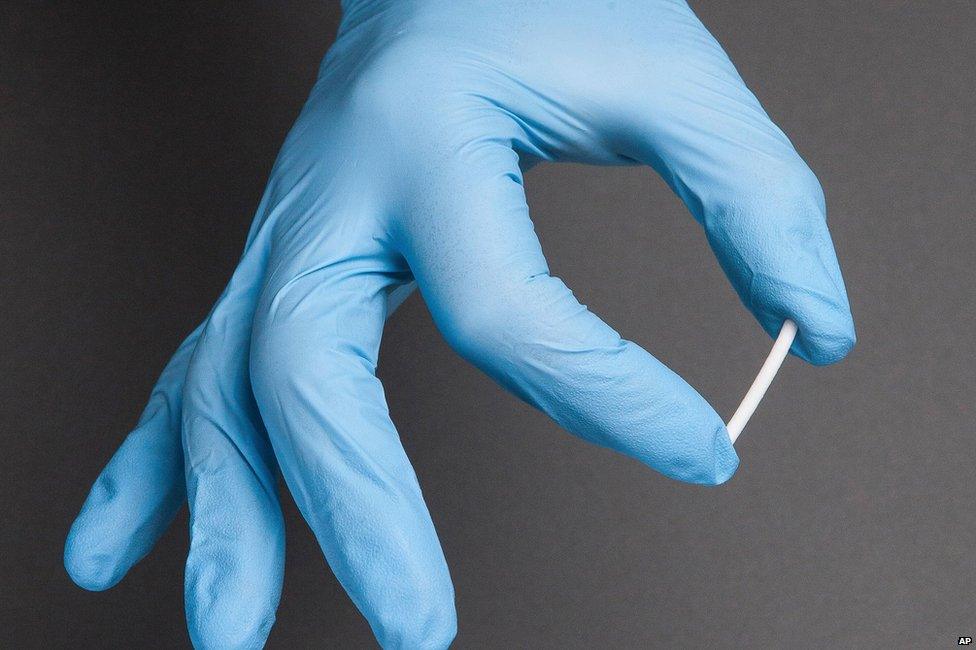It led to Prince's death, but what is the prescription medication fentanyl?
- Published

Prince's cause of death was an accidental painkiller overdose.
The Midwest Medical Examiner's Office released a report saying the singer died after taking a toxic amount of fentanyl.
It's a painkiller that America's Drug Enforcement Agency (DEA) says is 50 times more potent than heroin.
It's usually used in hospitals to treat cancer patients with severe pain, but the DEA says that it's also being used on the street to cut heroin.

This implant for a drug called buprenorphine is now being used to treat opioid addiction
What is fentanyl?
Fentanyl is an opioid that was first created by Paul Janssen, a Belgian who founded the pharmaceutical company, Janssen Pharmaceutica, in 1960.
It was introduced as an intravenous anaesthetic under the brand name Sublimaze.
In the mid-1990s it became available as a patch.
Even then, it was generally only given to patients with severe chronic pain, or those who'd built up a tolerance to weaker opioids.
Opioids are an addictive type of drug that target certain receptors in the brain. Heroin is an opioid, as are a number of other prescription drugs like morphine and codeine.

Michael Jackson also died of a prescription drug overdose, although he took demerol instead of fentanyl
Why is it so dangerous?
Because it's so much more powerful than other drugs, fentanyl can be harmful when it isn't taken under the supervision of a doctor.
The US Centre for Disease Control and Prevention (CDC) says there's been a 200% increase in deaths linked to opioids since 2000.
Between 2013 and 2014, the number of deaths after an overdose of a synthetic opioid, like fentanyl, almost doubled.

In America, a baby is born dependent on opioids every 19 minutes
Opioids can kill because they slow down the respiratory system. Taking too many, or mixing them with alcohol or sleeping pills, can make you lose consciousness or stop breathing.
Part of the problem is that it's made its way onto the streets in America.
Drug producers are adding it to heroin and selling it to recreational users who think it's a different drug.
In March last year, the DEA released a statement warning that fentanyl was a threat to public safety.
Where did the problem start?
In 1997, a report by the American Society of Anaesthesiologists and the American Pain Society encouraged doctors to prescribe more opioids to patients in pain.

Prince fans at a memorial gathering in LA
However, prolonged opioid use can make a patient build up a tolerance to it.
When that happens, a stronger drug like fentanyl might be used.
In 2014, it was prescribed more than six million times in the US.
It doesn't help that America's private healthcare system allows patients to visit a number of different doctors to get opioids, as long as they can afford it.

Actor Philip Seymour Hoffman died after taking heroin, cocaine, benzodiazepines and amphetamine in 2014
If they can't get the drugs legally, they might buy them from street dealers without knowing if they contain a deadly dose of fentanyl or not.
What's being done?
The CDC has released new guidelines advising doctors to be careful when they prescribe opioids to anyone who isn't a cancer patient.
New laws have been passed that mean doctors must check a database before prescribing opioids, to check how many times the patient has previously been prescribed them.
President Obama also announced in February that he wanted more funding put into addiction treatment programmes.
Find us on Instagram at BBCNewsbeat, external and follow us on Snapchat, search for bbc_newsbeat